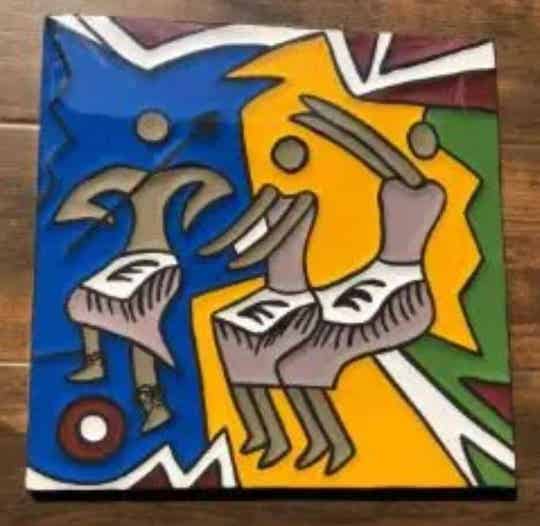Imigongo Patterns
Different Patterns: Geometric, Abstract, Culture (Rwanda traditional dance, music instruments, living style, etc.), Nature & Animal Art Forms painted on a wooden board, made of cow dung, ash, and natural dyes.

Geometric Art Forms
We offer a range of specialized services tailored to meet your individual needs.

Abstract Forms
We offer a range of specialized services tailored to meet your individual needs.

Culture & Nature
We offer a range of specialized services tailored to meet your individual needs.

New Collection
Don't miss out on the chance to save while enjoying the quality and service you love. Keep an eye on this space for the latest updates and grab these amazing deals while they last!
IMIGONGO
-
What is the history and origin of Imigongo art?
Imigongo (Kinyarwanda: [i.mí.ɡôː.ŋɡo]) is an art form popular in Rwanda traditionally made by women using cow dung. Often in the colors black, white and red, popular themes include spiral and geometric designs that are painted on walls, pottery, and canvas.
The images are produced using cow dung which is put onto wooden boards in spiral and geometric designs. The dung is mixed with ash, which kills bacteria and odor and is left to harden and is then decorated using colours made from organic material. The traditional colours are black, white, red, grey and beige-yellow but increasingly other colours are used.
What are the main steps and materials used in making it?
It starts with a wooden base plate that can range in size from a tiny photo frame to large-scale wall mural. The artist divides this plate into equal parts using banana fibers to ensure that the finished design is proportional then sketches geometric patterns—zigzags, spirals, diamonds, or squares—onto the plate with charcoal. The main medium is a mixture of fresh cow dung and ash, which kills bacteria and odor. The artist applies this malleable, dough-like paste by hand and painstakingly traces the desired pattern with the fingers, creating a raised relief. It takes the work about a day to air dry, and then it’s sanded for smoothness and covered in a neutral base coat of ochre to ensure that the rest of the colors will show up in uniform hues.
Once the work is dried, the artist paints designs in a simple palette of no more than four natural pigments. Traditional colors include white, derived from the clay mineral kaolin; red from the iron-rich Rwandan soil; yellow from ochre, another natural clay pigment; and a black created from banana peel ashes, aloe (ikakarubamba) sap, and poisonous soda apple fruit (umutobotobo). Increasingly, artists use a broader range of colors in more modern designs, but the traditional look continues to feature four colors or fewer.
What do the patterns and designs usually symbolize?
This is a geometric 3D art (the meaning of umugongo in Kinyarwanda), it is not about the cow dung. Dung was the major ingredient because it was the only available at that time. It shows Rwandans’ reliance on cows.
Imigongo is just one of the countless African geometric patterns known across the globe. It is also just one of the many Rwandan designs that were put on different things like baskets, pots, and mats.
How is this art practiced and preserved in Rwanda today?
The Rwanda Cultural Heritage Academy combined 136 of them in their book “Traditional Decorative Patterns.”
According to the book, the practice of decorating with geometric art is traced hundreds of years before the birth of Christ on ‘urewe’ ceramics.
For Imigongo, the design is traced back in the 18th century, in the Gisaka Kingdom – part of the present-day Eastern Province – during the reign of Kimenyi Getura, whose son Kakira was known to be unusually clean and neat. Prince Kakira is also known to have been creative with his hands, to design among other things, imigongo.
He conceptualised many designs in one of his father’s houses which he later converted as the reception area for high-level guests to his court.
The practice then became common, but initially among high ranking officials, until the rest of Rwandans adopted the culture. Now, it is still done and in many different ways.
Fashion and graphic designers have made it easier for anyone to not only have Imigongo frames hang in their houses, but also wear these designs, such as made in Rwanda haute couture worn by high end customers, although even those with limited means can rock the design.
imigongo and say ‘this is Rwandan,’ it is another kind of branding to the country,”

Has Imigongo helped empower women or support communities?
Absolutely — Imigongo has become a powerful tool for women's empowerment and community healing in Rwanda .
How Imigongo Supports Women & Community Impact
-
Revival after tragedy: After the 1994 genocide, women-led cooperatives like Kagitumba and Nyakarambi were formed to revive Imigongo. These groups provided widows and survivors with economic opportunities and a sense of purpose.
-
Economic independence: Through Imigongo, women earn income by selling their artwork to tourists and collectors, helping them support their families and gain financial autonomy.
-
Skill-sharing and mentorship: The art is passed down through generations, with older women teaching younger ones the techniques, fostering intergenerational bonds and preserving cultural heritage.
-
Healing and resilience: Imigongo became a medium for emotional recovery. Women used it to express grief, hope, and strength, turning trauma into creativity.
-
Youth engagement: Projects like the PPPF initiative have involved young women in creating Imigongo pieces that reflect their aspirations and challenge gender stereotypes.
-
Cultural pride: The art form has helped communities reconnect with their roots and celebrate Rwandan identity, especially in rural areas where traditions are deeply valued.
Imigongo isn't just decorative — it's a living symbol of resilience, creativity, and empowerment.
-














